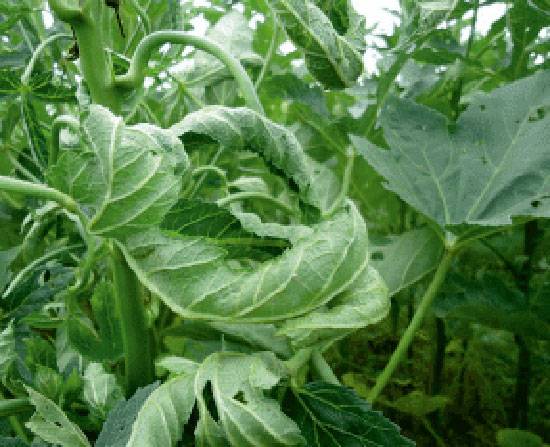Bhendi
Enation Leaf Curl

Vector: Whiteflies (Bemisia tabaci)
Viral Disease

Vector: Whiteflies (Bemisia tabaci)
Viral Disease

Vector: Whiteflies (Bemisia tabaci)
Viral Disease

Vector: Whiteflies (Bemisia tabaci)
Viral Disease
Enation leaf curl is a viral disease in okra (Abelmoschus esculentus), transmitted naturally by whiteflies (Bemisia tabaci). It affects plant growth, yield, and fruit quality. Below is an overview of its symptoms, transmission, and management strategies.
Symptoms
Leaf Symptoms:
- Small, pinhead-like enations on the lower leaf surface, which later become warty and rough.
- Leaves appear thick, leathery, and reduced in size.
- Twisting of leaf petioles is conspicuous.
Plant Deformities:
- Twisting of the main stem and lateral branches.
- Severe bending, causing the plant to appear as though creeping on the soil surface.
Fruit Impact:
- Few fruits are produced, and they are deformed.
- Newly emerged leaves in heavily infected plants also show bold enations, thickening, and curling.
Transmission
- Whiteflies serve as the primary vector for transmitting the virus.
Management Strategies
Vector Control:
- Use insecticides or biopesticides to manage whitefly populations.
- Deploy yellow sticky traps to monitor and control whiteflies.
Cultural Practices:
- Maintain proper plant spacing to improve airflow and reduce vector activity.
- Avoid planting okra near previously infected fields.
Resistant Varieties:
- Opt for resistant or tolerant okra cultivars where available.
Field Sanitation:
- Remove and destroy infected plants to minimize disease spread.
- Ensure field hygiene to discourage whitefly activity.
Key Takeaway: Managing enation leaf curl in okra requires an integrated approach, focusing on vector control, cultural practices, and resistant varieties to mitigate the impact of the disease and protect yield.





